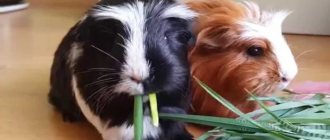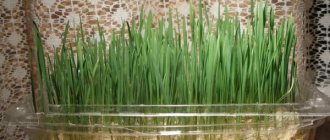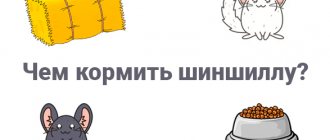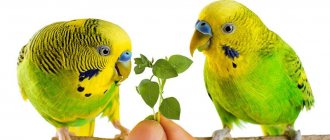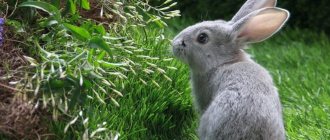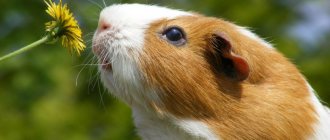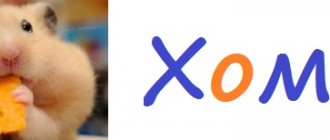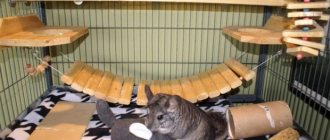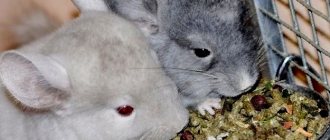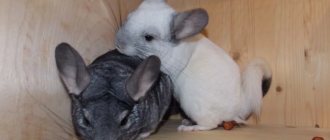Everyone understands perfectly well that rodents are herbivores, but they still wonder whether chinchillas can eat grass. Yes, it is possible and even necessary. There are many types of herbs that can be easily found in your local field or purchased at a pet store. Each of them has its own effect, which you definitely need to know about.
Hay is included in the mandatory diet of chinchillas, so the answer to the question of whether chinchillas can have grass is clear. The main thing is not to give herbs and tree leaves, which are strictly prohibited for chinchillas and can cause serious health problems for them.
Can a chinchilla have grass: feeding features
The main food supply for chinchillas is granulated food, grain mixtures and hay. But, from time to time they can be given grass. Herbs for chinchillas are feeding, not the main food, so you cannot feed them with grass alone.
Herbs contain many vitamins, minerals, and microelements that a pet simply needs for a full and long life. Moreover, it is believed that “green” food is chinchillas’ favorite treat. It is plants that contain protein and fiber, which are necessary for the favorable functioning of the gastrointestinal tract system, as well as for the general health of the chinchilla.
During the season when everything is in bloom, many owners of furry animals are puzzled by the question of whether it is possible to give chinchillas fresh grass. The fact is that fresh grass can cause an upset stomach in an animal.
So can chinchillas have fresh grass or not? It is important to observe moderation here; you can give your pet some fresh vegetation as a reward during training. And if you want to give more, then it is better to dry the freshly collected grass a little. It is better to use this feeding up to twice a week.
In addition, we must take into account that not all fresh grass is suitable for chinchillas to eat. For example, fresh clover and alfalfa can cause severe gas formation due to which the pet will suffer.
Also, in terms of chinchilla nutrition, it is important to consider that grass cannot completely replace food intended for pets. Therefore, in no case should you give up a good diet in favor of herbs alone. Despite the fact that they contain many useful substances, they cannot replace food.
Main menu
The chinchilla diet includes hay and twig food, grain mixture, vegetables, fruits, and berries. The animals are given greens and nuts as a healthy and tasty supplement.
To enrich the menu with vitamins and microelements, pets are given complex water-soluble vitamins: Beafar, Vita-Sol, Canina Petvital. The drugs are added to food or water according to the instructions.
Rough and juicy food
Rough feed includes hay and tree branches. This is the basis of the diet of a rodent, whose digestive tract is designed to digest food rich in fiber. Herbal granules contained in ready-made food for chinchillas cannot fully satisfy the animal's need for fiber.
Juicy food (vegetables, fruits, fresh herbs) are sources of vitamins and microelements for the animal’s body. You can feed your chinchilla the following foods:
- pumpkin, carrots, zucchini, cucumbers, root parsley, celery;
- apples, pears, melon, watermelon, seedless grapes, plums, bananas;
- berries of rowan, hawthorn, viburnum, rose hips, barberry;
- dried meadow grass, tops of legume garden plants, leaves of dandelion, honey, nettle and quinoa.
The amount of succulent food in a chinchilla's diet should be limited. The pet is allowed to give a piece no larger than a walnut per day. Large amounts of juicy foods can lead to diarrhea and bloating.
Combined feeds
Purchasing ready-made specialized mixtures greatly simplifies the care of feeding animals. The compound feed recipe is developed by scientists specifically for different groups of animals - young animals, pregnant and lactating females, adults. The composition meets the needs of the chinchilla and is balanced in the amount of proteins and fats.
In addition to ready-made food, the pet must be provided with hay. Occasionally you can pamper the animal with a treat.
At home, chinchillas happily eat food from the following brands: Little On, Waka, Vitacraft, Versel-Laga. Preference should be given to granulated food, from which the pet will not be able to choose the most delicious pieces, ignoring the rest of the food.
Vitacraft Little On Vaca Vercel-Laga
For rodents (chinchillas, rabbits, guinea pigs), you can buy hay at a pet store. But you can prepare dry grass yourself at the rate of 120–180 g per head per day.
For drying, grasses are cut when they are just about to bloom - at this time the content of nutrients and vitamins is highest. It is better to dry in the shade so that the hay remains green and fragrant. Various plants are suitable for harvesting:
- The chinchilla readily eats hay from meadow grasses (cocktail grass, foxtail grass, wheatgrass, fescue, bromegrass, bluegrass, timothy grass).
- It’s good if the hay contains chamomile, tansy, wormwood, and plantain. These medicinal herbs are useful for the animal’s digestion.
- Nutritious and tender bean hay from clover, alfalfa, sainfoin.
- Dried tops of carrots and peas, leaves of corn, nettle, and mint will be an excellent addition to hay.
You should avoid including nightshade, horsetail, fern, henbane, celandine, datura, cornflower, crow's eye, and sweet clover in the food.
Hay should be stored in linen bags in a dry and dark place.
Hard food
In the wild, chinchillas eat seeds of wild cereals. At home, animals can be fed with a mixture of regular grains:
- Whole oats are an easily digestible, non-obesifying food. The grain can be replaced with oatmeal.
- Corn is nutritious and rich in protein, but in large quantities it can cause bloating.
- Wheat is a nourishing, balanced product.
- Barley is given only in crushed or flattened form.
- Sunflower seeds are given raw; they are rich in fatty acids necessary for rodents.
- Hemp and flax seeds are healthy products for chinchilla digestion.
In percentage terms, the basis of the grain mixture for a rodent is oats (up to 70%), wheat and corn are given in equal shares, flax and sunflower seeds - no more than 5% of the total mass of the mixture.
It is useful to give part of the grain in sprouted form, the size of the sprouts is up to 10–15 mm.
What grass can you give to chinchillas?
In order not to harm the health of your pet, you need to know what grass chinchillas can eat and whether it is possible to give chinchillas dandelions (this is one of the most common and accessible plants in the spring and summer). We suggest that you familiarize yourself with the list of herbs approved for consumption for chinchillas:
- Spinach – rich in proteins, magnesium and iron;
- Nettle - perfect as complementary food during the molting period, or if the female animal is pregnant;
- Apple leaves – improve digestion;
- Rosehip – suitable as a tasty treat;
- Plantain – has a sedative and anti-inflammatory effect, can be used to strengthen the immune system during an animal’s illness;
- Dandelions – many owners doubt whether chinchillas can have dandelions. So, dandelions are useful for chinchillas, and you can give them any parts of this plant: flowers, leaves and roots. The greatest amount of useful elements is contained in the leaves of this plant;
- Raspberry leaves – used as an additive to hay;
- Burdock – improves metabolism;
- Chamomile – helps cope with gastrointestinal disorders. The main thing is not to overdo it, otherwise the effect will be exactly the opposite;
- Parsley – increases appetite, restores immunity;
- Bird knotweed is a rich source of various vitamins;
- Lingonberry leaves are suitable for general health;
- Strawberry leaves and flowers strengthen the walls of blood vessels.
Each plant has its own set of unique properties, so it's not just a treat or treat. You need to select herbs to feed your animal based on its health status and needs.
Something to chew on
The chinchilla needs to be given something to chew on. To do this, you need to give twigs or blocks of safe trees and stones with minerals that are sold for rodents. If you don't provide them with wood, they will chew on shelves and other things in the cage, because it is vital for them to grind down their teeth.
The easiest trees to find in our area that are safe for chinchillas are:
Before giving chinchillas twigs or tree dies, they must be poured with boiling water and cleaned with a stiff brush so that excess dirt and harmful bacteria are removed. Next, you need to dry them in the oven or electric dryer.
If you use tree dies, you need to fasten them together with aluminum wire, making holes in the middle. And the branches just need to be thrown into the cage.
In addition to pieces of wood, they can also buy something like crayons that contain calcium. It’s better not to look for them yourself, but to buy them at a pet store so that they can tell you which stone will suit your rodent.
What herbs should not be given to a chinchilla?
When trying to diversify your pet’s diet, do not forget that not all herbs can be given to chinchillas as food. There are also those plants that are poisonous to chinchillas and can cause not only poisoning, but also death.
The list of herbs prohibited for consumption by chinchillas includes the following plants:
- Bird cherry;
- Celandine;
- Chestnut;
- Acacia;
- Spurge;
- St. John's wort;
- Cherry;
- Acacia;
- Fir;
- Cypress;
- Buckthorn;
- Yew;
- Melia;
- Eucalyptus;
- Buttercup;
- Sitnik;
- Sedge;
- Crow's Eye;
- White hellebore.
If you are not sure what kind of herb you are giving to your pet, then it is better to refuse such a treat altogether, otherwise you can, at best, fork out for the treatment of the animal, and at worst, cause the death of your pet.
Products prohibited for rodents
When monitoring a chinchilla's diet, it is important to remember that the pet is forced to eat what a person offers it. It is not always the case that an animal, relying on instinct, will refuse harmful food, as it would do in the wild.
List of products that are deadly and harmful to animal health:
- meat and dairy products (only nursing females can be given tea with milk instead of water);
- any mushrooms;
- raw and boiled eggs;
- bread, pasta;
- potatoes in any form;
- roasted nuts, seeds;
- thermally processed food, sweets.
You should not give your pet shoots of the following trees: spruce, pine, lemon, apricot, cherry, plum, lilac, bird cherry, maple, elderberry.
Taking into account the peculiarities of the diet and restrictions in the choice of products for chinchillas, novice animal owners are recommended to buy high-quality specialized food, supplementing the menu with good hay.
Useful tips when feeding grass
A few tips will help you create the best menu for your pet:
- The best period to feed your animal herbs is the beginning of spring. During this period, herbs are maximally saturated with beneficial elements.
- Fresh plants are best dried for 2-3 hours, preferably in the sun.
- If the plant has fruits, then you cannot give them to your pet (except for dandelion); only the “green” parts of the plants are suitable for food.
Chinchillas love grass and are ready to eat it all the time, but this does not mean that you need to pamper your pet. How healthy his little animal will be, and how rich and correct his diet will be depends only on the attentiveness of the owner. When feeding this way, be sure to use the list of what grass chinchillas can eat. If you give the animal the right treats, it will be happy and thank its owner!
Foods that can be given in limited quantities
The list of products that chinchillas are fed at home includes some that can be given to the animals in small quantities.
- Nuts, sunflower seeds, peas, lentils, corn are highly nutritious food, rich in protein and fat . If the rodent is overfed with these foods, it becomes fat and its digestion may be impaired.
- Juicy greens (lettuce, dandelion) and vegetables (cucumbers, zucchini) are loved by animals, but these foods weaken them. Each day, one animal is given half a leaf of lettuce or one slice of cucumber 3–4 mm thick.
- Sweet fruits and berries are a favorite food for chinchillas, but in large quantities they can lead to metabolic failure.
- branches of plants such as raspberry, willow, oak, alder and birch no more than once a week.
Each product new to the animal is given in the smallest dose, observing the pet’s behavior. If there is no deterioration in health within 24 hours after the introduction of the food, the product can be offered in an increased volume.
Store-bought treats
In order not to rack your brains wondering what you can give your chinchilla and what will be harmful to it, it is better to go to a pet store and buy a specialized treat. The finished formulations are not only absolutely safe for animals, but also contain a large amount of vitamins and mineral supplements. The most popular treats for chinchillas are:
It is worth noting that the listed treats for fluffies can be purchased at a very affordable price. The cost of treats for a chinchilla ranges from 100 to 300 rubles. At the same time, one medium package weighing 100 g will last a pet for 10-12 days.

